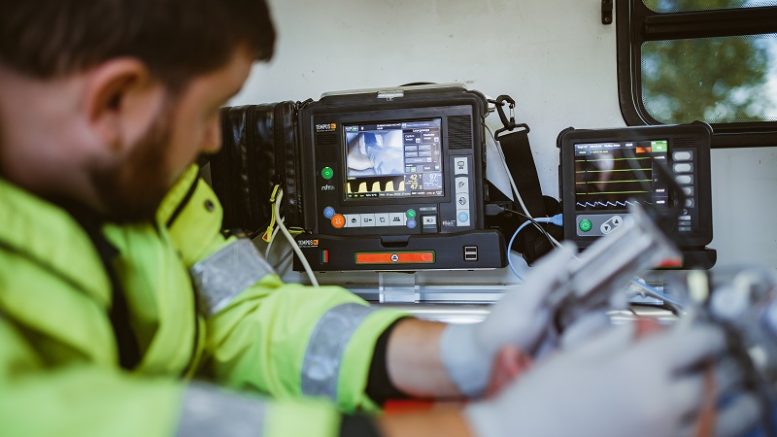By Graham Murphy, BU Leader of RDT – a Philips Company
The healthcare sector is in the midst of a technology revolution. The NHS has embedded technology integration into its long-term strategy, with particular emphasis on innovative technological approaches to improve efficiency and sustainability, empower patients and improve their experience.[1,2] Technology has also been recognised as one of the two fundamental ‘enablers’ of a more effective ambulance service.[3]
The second enabler is staff.[3] The role of the paramedic has evolved at a rapid pace, due to increasing demands on the service coupled with limited resources. The Association of Ambulance Chief Executives’ (AACE) vision of the ambulance service for 2020 sets out the ambition to re-position the ambulance as a ‘mobile healthcare unit’, which will result in increasing demand to deliver treatment and care in the pre-hospital space.[3]
The success of this strategy will hinge on unifying these two ‘enablers’. From this arise two key visions; the ‘smart’ ambulance, and the ’data-empowered’ paramedic. Underpinned by innovative technology, these two concepts can work hand-in-hand to shape the future of the ambulance service. Whilst in the UK the smart ambulance is still a more long-term vision, the technology required to enable the data-empowered paramedic is already here.
The ‘Smart Ambulance’
In the last two decades, there have been various initiatives around the world focused on designing a model ‘smart ambulance’. Driven by their sprawling geography and the long distances ambulances often have to cover to get patients to hospital, countries like the US and Australia are now ahead of the game in terms of ambulance design. Responding to the increased need for more self-sufficient, well-designed ambulances with better diagnostic and treatment capabilities, in 2016 two companies in Australia unveiled their joint prototype Smart Ambulance to Australian and New Zealand ambulance authorities. This promised a safer working environment for paramedics, more efficient fleet management and improved real-time communication of patient conditions with hospitals.[4]
In Europe, which tends to be more densely populated, until recently there has been less need to innovate in ambulance design. In the last decade however focus has shifted, with various initiatives gaining pace. In 2011, the Helen Hamlyn Centre for Design put out a report, in collaboration with the London Ambulance Service among others, outlining their design for a ‘new and innovative ambulance interior’.[5] Following this, the Smart Ambulance: European Procurers Platform (SAEPP), funded by the European Union’s Horizon 2020 research and innovation programme, was set-up in 2015. The project’s aim was to standardise the ideal ambulance specifications across the EU and build a working prototype smart ambulance,[6] however it does not appear to have progressed past the consultation stage. More recently in the UK, there have been trials of mobile stroke units at several sites; ambulances which integrate an array of additional diagnostic technology to increase treatment rates ensure faster time-to-treatment, which is vital for stroke patients.[7]
Whilst the smart ambulance is an evolving concept, these initiatives all share a common goal: to improve the ability to treat patients on-scene and provide better connectivity with other hospital services. The 2020 vision of the ambulance service outlines the ambition for ambulances to become ‘connected mobile treatment centres’ that can stream live patient data.[3] Better connectivity between ambulance services and hospitals will help to further integrate the service with other NHS services, making the care continuum more efficient and leading to better patient outcomes. It is also one of the major strategic approaches for sustainability.[8]

Smaller, lighter and connected solutions can be deployed in all vehicle types. Care begins outside the ambulance.
Empowering Paramedics
The smart ambulance has not yet been widely adopted in the UK, and it may be some time before working prototypes are on the roads. This is why the vision of the data-empowered paramedic must be supported in parallel with the smart ambulance. Care begins outside the ambulance, with the paramedic or the first responder, so they need to be better supported by the technology they carry not just the ambulance itself.
As with the smart ambulance, there is now a pressing need to improve paramedics’ telemedicine capabilities and better connect them to emergency departments. They already use portable remote-monitoring and defibrillation devices, but many current devices capture a snap-shot of data and do not have the ability to stream rich, event-driven patient information in real-time.
The real-time flow of patient data, including pictures and videos, directly from the device in their hand would enable paramedics to make better onward care and on-scene treatment decisions with support from the relevant contact in hospital. Automatically capturing the data instead of having to manually record it will also allow paramedics to focus on the task in hand. Additionally, it provides a more accurate record of events, which paramedics can review and learn from to build their confidence.
At present, some telemedicine technologies are not being used to their full potential. Many people hold a fairly one-dimensional view of the ambulance service,[3] and local care pathways may not give paramedics licence to spend time treating on-scene. As recognised by the AACE, truly empowering paramedics will mean equipping them with the skills and confidence to deliver high-quality urgent care,[3] but this ambition must be supported on all sides. With new technologies on the horizon for later this year, this could all be set to change.
The Future of Connected Care
The smart ambulance and the data-empowered paramedic will ensure seamless data flow across the care continuum, promoting better connectivity between ambulance services and other NHS departments. The smart ambulance cannot reach its full potential without the data-empowered paramedic, and with no smart ambulance in the UK ready for deployment yet, the latter should be our immediate focus.
A complete solution to empower paramedics will be launched later this year. RDT’s Corsium enhances paramedics’ existing toolkit of the Tempus ALS monitor and defibrillator, with an ‘ecosystem’ of data capture and real-time data streaming to any device.
Supporting and enhancing paramedics’ decision making will streamline the patient experience and help reduce the number of unnecessary ambulance transports, making the healthcare service more efficient and reducing pressure on A&E. The data collected can also help to inform strategy and enrich training for ambulance staff and the healthcare system more broadly. The data collected can also be easily flowed into upstream patient record systems.
With Corsium at its heart, the visions of both the smart ambulance and the data-empowered paramedic will be integral to the future of a more connected and integrated emergency response.
References
[1] NHS England. Five Year Forward View; 2014
[2] Mak A. Powerful patients, paperless systems. Centre for Policy Studies; 2018
[3] Association of Ambulance Chief Executives. A Vision for the ambulance service: ‘2020 and beyond’ and the steps to its realisation; 2015
[4] Process and Control Engineering (PACE). Australian Smart Ambulance to revolutionise communications with hospital emergency; 2016. Available at: https://pacetoday.com.au/australian-smart-ambulance-to-revolutionise-communications-with-hospital-emergency/ (accessed June 2018)
[5] Matthews E, Fusari G, Harrow D et al. Redesigning the emergency ambulance. Helen Hamlyn Centre for Design; 2011.
[6] Smart Ambulance: European Procurers Platform (SAEPP). About us; 2015. Available at: http://www.smartambulanceproject.eu/about-us/ (accessed June 2018)
[7] Southend University Hospital. Southend University Hospital plans Mobile Stroke Unit project; 2018. Available at: http://www.southend.nhs.uk/about-us/media-centre/southend-news/nr18-(2018)/ (accessed June 2018)
[8] NHS England. Transforming urgent and emergency care services in England, Clinical models for ambulance services; 2015


